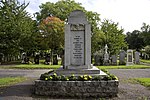Roman Catholic Diocese of Paisley

The Diocese of Paisley (Latin: Dioecesis Pasletana) is an ecclesiastical territory or diocese of the Latin Church of the Catholic Church in Scotland. Erected on 25 May 1947 from the Archdiocese of Glasgow, the diocese covers the historic county of Renfrewshire (now the local government areas of Renfrewshire, East Renfrewshire and Inverclyde) and is 580 km2 (220 sq mi) in area making it the smallest diocese by area in Scotland. In 2004 the Catholic population of the diocese was 79,400 out of a total population of 342,000 (23.2%). By 2016 membership increased to 88,600 (23,8%) out of a total population of 372,800. The diocese comprises 33 parishes served by 30 priests (2021 figures). The diocese is divided into three deaneries namely St Mirin's Deanery (Renfrewshire), St Mary's Deanery (Inverclyde) and St John's Deanery (East Renfrewshire).The mother house of the religious society the Jericho Benedictines is in the village of Kilbarchan, near the town of Johnstone within the diocese. The Diocese is led by the Bishop of Paisley, currently the Right Reverend John Keenan, the fifth bishop of the diocese. The mother church of the diocese and seat of the bishop is St Mirin's Cathedral in the town of Paisley. The motto of the diocese is "For the Good of Souls".
Excerpt from the Wikipedia article Roman Catholic Diocese of Paisley (License: CC BY-SA 3.0, Authors, Images).Roman Catholic Diocese of Paisley
Glasgow Road,
Geographical coordinates (GPS) Address Nearby Places Show on map
Geographical coordinates (GPS)
| Latitude | Longitude |
|---|---|
| N 55.847 ° | E -4.416 ° |
Address
Glasgow Road
Glasgow Road
PA1 3PX , Williamsburgh
Scotland, United Kingdom
Open on Google Maps








